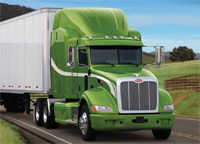here come the hybrids

This past summer, the Port of Los Angeles saw an unusual sight—an electric truck ferrying containers from terminals to warehouses and rail yards. The truck, a prototype vehicle, was a short-haul drayage truck capable of pulling a 60,000-pound cargo container at a top speed of 40 miles an hour.
The experimental truck, which produces zero emissions, has been greeted with enthusiasm in California, which has adopted a number of regulations to improve air quality. "We could eliminate a lot of truck pollution in and around the port with a fleet of these workhorses," said Los Angeles Harbor Commission President S. David Freeman in a press release.
Testing of the prototype, which was manufactured by Balqon Corp. of Santa Ana, Calif., was still under way at press time. The port planned to put the truck into regular service to see how it would hold up under the daily stress of draying loads. However, early results have been sufficiently encouraging that the port has already decided to purchase five more of the vehicles, which go for about $208,000 apiece.
Given the high cost of diesel these days, the idea of using electric trucks has undeniable appeal. But no matter how well the prototype performs, battery-powered trucks will likely be limited to short-haul drayage applications, at least in the near term. Their range makes them impractical for extended highway use. When loaded, the prototype vehicle being tested in Los Angeles can go only 30 miles before needing a battery charge (Balqon says unloaded trucks can travel up to 60 miles without a recharge).
Although it's unlikely we'll see all-electric trucks tooling down America's highways anytime soon, a variation on the electric truck—the hybrid diesel electric—shows a great deal of promise. In the past year, a number of truck makers have begun production on mid-sized trucks with hybrid electric systems similar to what's used in automobiles. Although some question whether the technology will ever be a good fit for the biggest of the big rigs—Class 8 trucks—mid-sized trucks using hybrid technology are already starting to appear in dealer showrooms and even on the nation's highways.
All charged up
The hybrid trucks currently on the market use what's known as "parallel electric" technology—the same technology that powers passenger cars like the Toyota Prius. "You have an electric motor that works alongside an internal combustion engine," says David Alexander, an analyst at ABI Research of Oyster Bay, N.Y., who wrote a report on hybrid technology last year. "The electric motor provides a boost to the ... engine to take some of the load off and reduces consumption of fuel." These vehicles also save energy in stop-and-go driving through "regenerative braking," a technology that allows the vehicle to capture energy when the driver brakes and store that energy in a battery for reuse in restarting and low-speed operation.
Parallel electric technology is particularly well suited to trucks used in local delivery service. The vehicles' frequent stops and starts create plenty of opportunities to capture energy for the battery through braking. "Hybrid trucks work well in stop-and-go traffic," says Daniel Sperling, director of the Institute for Transportation Studies at the University of California at Davis. "You can get back the extra cost for a hybrid electric truck in a short time span."
Small vans using parallel electric technology—technically considered Class 4 and 5 trucks—have been around for five years. But recently, truck manufacturers have begun applying parallel electric technology to the larger Class 6 and 7 trucks as well. In Sweden, for instance, Volvo Trucks is currently running a pilot to test the technology on trucks designed for collecting trash.
Here in North America, Navistar International of Warrenville, Ill., started manufacturing hybrid Class 6 and 7 trucks a year ago. "At low speeds, the truck is powered by an electric engine," says Mark Johnson, the company's marketing manager. "At 25 miles an hour, the diesel engine kicks in."
At press time, Johnson said his company had sold 200 of these hybrid commercial trucks, which command a premium price compared to traditional vehicles. How much of a premium? Johnson says a traditional Class 6 or 7 truck goes for $45,000 to $60,000, depending on the specifications, while a hybrid unit costs somewhere between $80,000 and $90,000. He notes, however, that fuel savings help offset some of that price differential. "You'll see fuel savings between 30 and 40 percent," says Johnson. "At $4.50 for a gallon of diesel, the truck could pay for itself in three to four years."
Early this year, Freightliner of Portland, Ore., announced that it, too, was beginning production on a hybrid medium-duty truck—the M2 106, a Class 6 truck designed for hauling beverages. Although the company, which is part of Daimler Trucks North America LLC, declined to release sales or production numbers for the truck, David Bryant, Freightliner's vocational sales manager for hybrid vehicles, says he's seeing a lot of people "pulling the trigger on orders now."
Peterbilt Motors Co. of Denton, Texas, has also announced plans to begin making medium-duty dieselhybrid vehicles. A plant in Ste. Therese, Quebec, began production on both a Class 6 and a Class 7 hybrid truck this summer. The two models use a parallel hybrid system with an electric motor alongside a diesel engine. Peterbilt spokesman David Giroux says that a wine distributor in California has already placed an order for the hybrid diesel trucks, which it plans to begin using this fall.
Are Class 8s feasible?
Not content with building only mid-sized hybrid trucks, Peterbilt has plans to scale up hybrids to Class 8s, the largest trucks. The Texas truck maker is currently working with Wal-Mart Stores to develop a Class 8 prototype. After the tests with Wal-Mart are finished, Giroux says, his company will decide whether to take the Class 8 hybrid truck into production.
A number of industry experts are skeptical that over-the-road tractors pulling 80,000-pound loads can run successfully on parallel electric technology. "The concept of scaling up a Prius technology for a Class 8 truck is a nonstarter," says Alexander of ABI Research. "It's difficult for hybrids to work on Class 8 trucks because most of their operation involves cruising at 60 miles an hour or better."
In fact, Alexander says, it's more likely that with Class 8 trucks, truck manufacturers will end up using the hybrid technology to run ancillary systems like airconditioning units, cooling fans, or power steering, which now sap power from the engine. "It will not double fuel economy," he says. "But 5 percent here and 2 percent there add up."
Peterbilt spokesman Giroux acknowledges that adapting Class 8 trucks to use Prius-type technology presents some challenges. One of those is fuel efficiency. While mediumduty hybrids can expect fuelefficiency gains in the range of 30 to 60 percent, he says, gains for heavyduty hybrids would likely be only 7 to 15 percent. "In the medium-duty trucks, there's a payback because of the stop-and-go cycle," he says. "It's more difficult if you're traveling long distances because you're not stopping to regenerate the batteries."
At least one trucking expert believes we may yet see Class 8 hybrid trucks on the highways, though they'll most likely be used for regional transportation, moving loads from warehouses to retail stores, for example. As prices for big rig hybrids drop, companies may be able to justify the purchase of Class 8s used in local distribution, says Bill Van Amburg, a senior vice president at CalStart, a Pasadena, Calif.-based nonprofit organization that works with both the public and private sectors to develop advanced transportation technologies. "Hybrids will not take over Class 8 trucks," he says, "but it would be short-sighted to say it won't be a fit in the future."
More avenues to explore
Even if parallel electric technology proves impractical for heavy-duty trucks, Alexander says, truck manufacturers could try other approaches, such as "ultracapacitor" technology. Unlike batteries, which store energy in a chemical form, ultracapacitors store electric charges on plates. "It allows a lot of energy to be stored quickly and released quickly," says Alexander.
Another option would be to deploy what's known as a series electric system, which General Motors is using in the development of its Chevrolet Volt automobile. In that type of system, an electric motor runs the vehicle all the time, and a gasoline engine simply recharges the battery. But that's not an option for big trucks right now. "They need bigger batteries than are available today for this to work," says Alexander.
With the era of cheap oil apparently over, truck manufacturers will surely continue to experiment with technology and develop variations on hybrid trucks of all shapes and sizes. In the meantime, though, American truck manufacturers are gearing up for a surge in sales of medium-sized hybrid electric trucks. "We expect our sales to grow exponentially next year," says Johnson of Navistar International. "Customers are realizing that higher diesel prices are a long-term change, and they have to invest in their equipment to mitigate the increases in fuel prices."
Related Articles

Copyright ©2024. All Rights ReservedDesign, CMS, Hosting & Web Development :: ePublishing